Queen Elizabeth: Monarch with a genuine love for Scotland
- Published
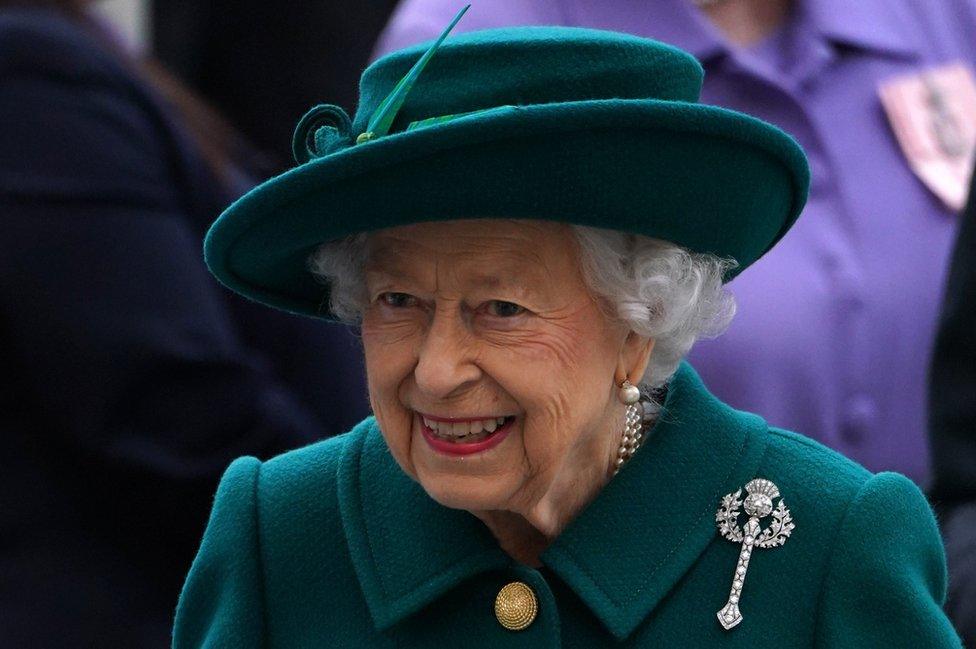
The Queen attended the opening of the sixth session of the Scottish Parliament in October 2021
Throughout her long life Queen Elizabeth was always keen to display her love and enthusiasm for Scotland.
Her mother, the youngest daughter of the 14th Earl of Strathmore, was from a Scottish family, who lived at Glamis Castle in Angus.
And Balmoral Castle on Royal Deeside was one of the few places she could relax and do the things she loved.
When she was born, in April 1926, there did not seem to be much chance of the princess ever sitting on the throne.
However, the death of her grandfather George V and the abdication of her uncle, Edward VIII, meant that at the age of 10 her father became king - and she was next in line.
The young princess spent a lot of time in Scotland, either with her parents at Balmoral or with her maternal grandparents at Glamis.

Princess Elizabeth with her grandparents King George V and Queen Mary on the way back to Balmoral after attending church at nearby Crathie in September 1932
Holidays at her mother's family home were an early memory.
At the age of 11, she wrote to her grandmother, the Countess of Strathmore, saying: "Darling Granny, Thank you very, very much for having us to stay at Glamis.
"We had such a loyal, if I might say so, reception at the station, and when we went out on the platform, the crowd sang 'Will ye no come back again', which was very nice of them.
"It was one of the happiest weeks I have ever spent."
While still a teenager, in 1944, the then Princess Elizabeth gave her first public speech in Aberdeen, opening a home for the British Sailors' Society.
With World War Two still raging, she praised the seafaring community as "the men who go down to the sea in ships. The men on whom our very existence depends".
Holidaying at Balmoral
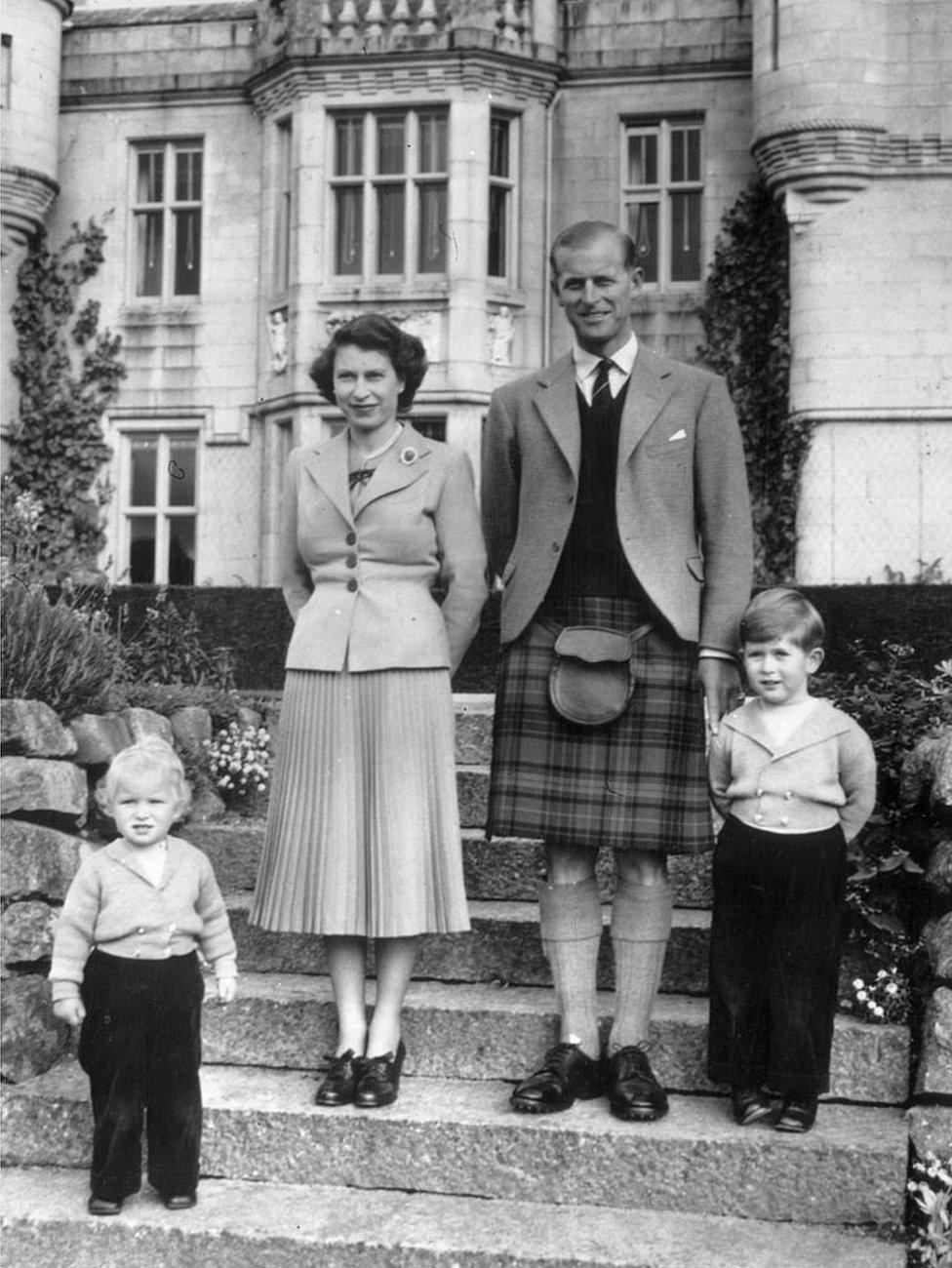
The Queen and Prince Philip with their two young children, Princess Anne and Prince Charles, outside Balmoral Castle in 1952

After the Queen ascended to the throne in 1952, she maintained the Royal family's tradition of holidaying at Balmoral.
Sir Malcolm Ross, former Comptroller of the Royal Household, who died in 2019, told the BBC it was always a time for family.
He said: "The weather's not perfect, but it's the setting, it's the place, it's the atmosphere, it's the feel.
"It's the wide open spaces. No distractions, no aeroplanes, no noise, no traffic. Just this lovely estate where she can freely roam everywhere.
"She can relax, with her dogs, just doing what she thought normal people did, and indeed what normal people do."

Queen Elizabeth and Prince Charles watch the action during the Braemar Highland Games in September 2014
The Queen looked forward to her annual family holiday at Balmoral.
She always enjoyed walking and riding on the estate as well as spending time in the wider community, attending Crathie Kirk or visiting friends and relatives who live locally.
The only formal occasion of the holiday was the annual Ghillies Ball, when estate workers danced with the Royal Family - who are all schooled in Scottish country dances.
Local people, including members of the Scottish Womens' Rural Institute (SWRI), were often invited to attend.
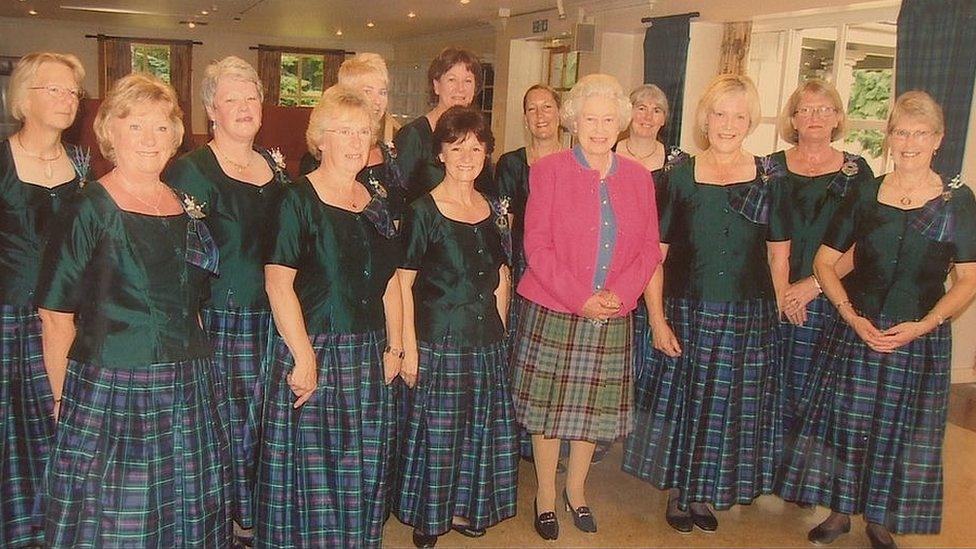
The Queen with dancers from Upper Deeside SWRI
Pat Thomson, the chair of the SWRI's Upper Deeside branch, said this showed that the Queen cared about her local community.
Ms Thomson said: "I had the pleasure of introducing her to all of the dancers, one of whom she looked at - scrutinised - and I thought: 'You're for the Tower'.
"But she said: 'You gave me the baggie at church on Sunday for the collection.'
"She recognises people, and it does mean something to her."
Official duties
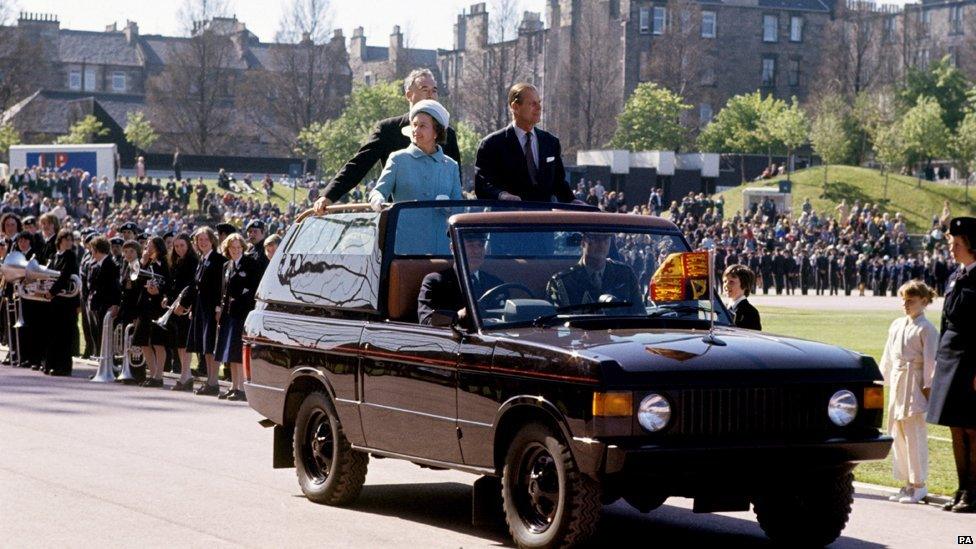
The Queen and the Duke of Edinburgh tour Meadowbank Stadium in Edinburgh in 1977
Whenever she was in Scotland, the Queen also turned her attention to her day job - and a variety of routine and not-so-routine official duties.
In recent years she has named the Royal Navy's largest warship, the aircraft carrier HMS Queen Elizabeth, and opened the Queen Elizabeth University Hospital in Glasgow.
She also inaugurated the Borders Railway between Edinburgh and Tweedbank on the day in 2015 that she became the UK's longest-reigning monarch, overtaking Queen Victoria's record.
One of the Queen's most unusual visits was in 1958 to the newly-opened Rothes Colliery in Fife. In a white boiler suit, white headscarf and miner's helmet, she descended 1,600ft (500m) in the cage to walk to the coal face.

The Queen wearing miner's overalls before descending the mine at Rothes Colliery in Fife
She was the first monarch since George V to go into a pit, and newsreel pictures at the end of the visit show the boiler suit was still pristine white.
Throughout her reign, the Queen has visited virtually every part of Scotland.
She has opened the Scottish Parliament's sessions, addressed the General Assembly of the Church of Scotland, opened numerous bridges and launched many ships.
She has made history on many occasions, including in 1960 when she became the first reigning monarch since the Viking King Haakon to visit Shetland.
There was another first in 2022 when the appointment of Liz Truss as the new prime minister took place at Balmoral. The previous ceremonies had all taken place in London at Buckingham Palace.
The Queen and Scottish politics
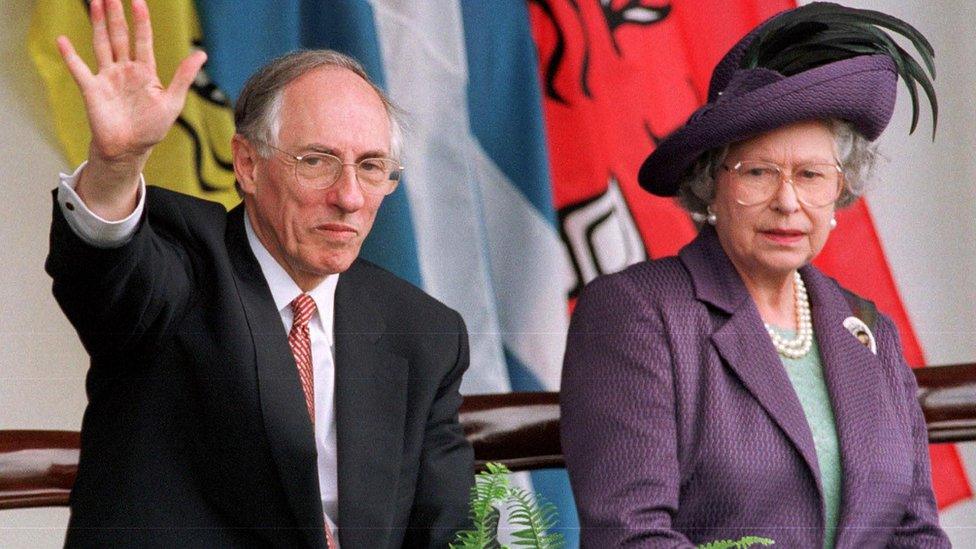
Scotland's first First Minister Donald Dewar watches the parades from the Royal Dias with the Queen after the opening of the Scottish Parliament in Edinburgh in July 1999
In 1999, the Queen flew from London to the Palace of Holyroodhouse in Edinburgh to greet Scotland's first First Minister Donald Dewar.
In earlier times she had sounded decidedly sceptical about devolution.
During her Silver Jubilee year in 1977, she said she could "readily understand these aspirations" for Scottish self-government.
But she then added: "I cannot forget that I was crowned Queen of the United Kingdom of Great Britain and Northern Ireland."
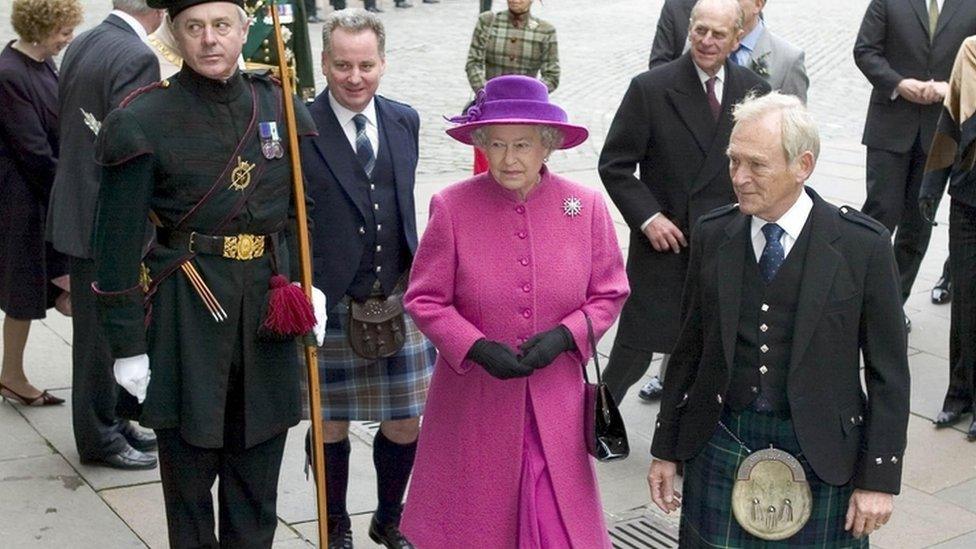
Queen Elizabeth arrives at Parliament Square in Edinburgh, flanked by First Minister Jack McConnell (fourth from left) and Presiding Officer George Reid (right) in October 2004
But times changed, and so did the palace.
On her Golden Jubilee in 2012, when the Queen addressed MSPs in Aberdeen, she said: "I value the distinctive contribution that Scotland is making to strengthen the bonds that link the nations and regions of the United Kingdom, the Commonwealth and Europe."
This was seen as her adapting to the new devolved settlement, within the structures of the United Kingdom.
The new, devolved Scottish Parliament gained power on 1 July 1999.
In her address at the opening of the parliament, the Queen said that Scotland "occupies such a special place in my own and my family's affections".
She added: "I have trust in the good judgement of the Scottish people, I have faith in your commitment to their service and I am confident in the future of Scotland."
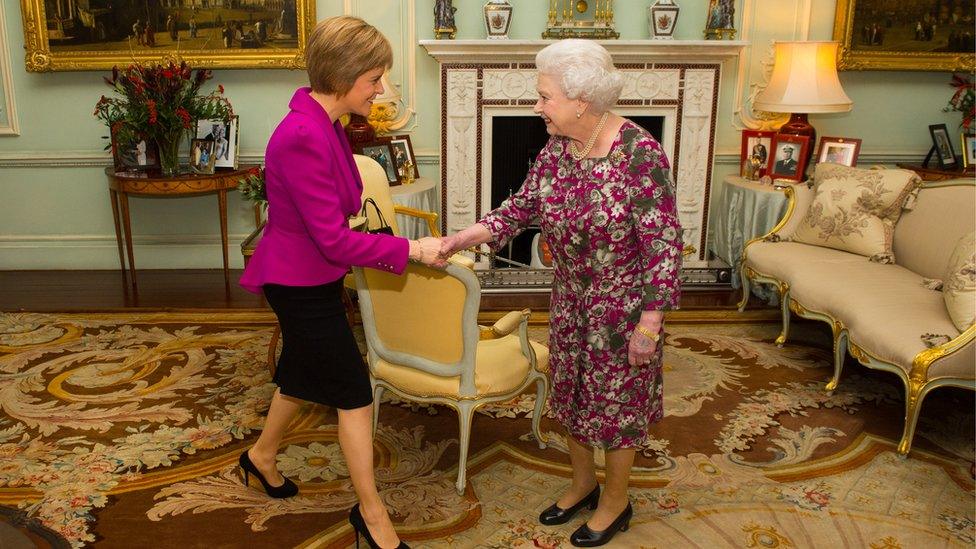
Queen Elizabeth holds an audience with the First Minister of Scotland Nicola Sturgeon at Buckingham Palace on 10 December 2014
Five years later the Queen got new Edinburgh neighbours when she opened the new parliament building at Holyrood.
The Queen was again in parliament in 2007 when the SNP took power. First Minister Alex Salmond talked of independence but endorsed the monarchy.
He acknowledged her "vital roles as Queen of Scots in guiding the tenor of our deliberations".
In 2011, the Queen gave a Royal reflection on the robust nature of Scottish discourse.
She told MSPs: "No-one would ever argue that Scottish politics is the business of the meek, passive or the faint-hearted."
The Queen spoke about her affection for Scotland and the challenges of Covid
In 2014, as Scotland prepared to vote on Scottish independence, the Queen was reported to have said she hoped "people will think very carefully about the future".
While some suggested that this indicated her concern over the vote, Royal officials insisted any suggestion that the Queen would want to influence the outcome of the referendum was "categorically wrong".
In 2021, the monarch attended the Scottish Parliament's opening ceremony without Prince Philip, who died earlier in the year aged 99, for the first time.
She said: "I have spoken before of my deep and abiding affection for this wonderful country and of the many happy memories Prince Philip and I always held of our time here.
"It is often said that it is the people that make a place and there are few places where this is truer than it is in Scotland, as we have seen in recent times."
She said the new session of parliament brought with it "a sense of beginning and renewal" and an opportunity for hope and optimism amid "adverse and uncertain times".
Related topics
- Published8 September 2022

- Published21 April 2016